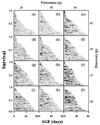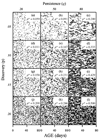Stochastic dietary restriction using a Markov-chain feeding protocol elicits complex, life history response in medflies
- PMID: 15659211
- PMCID: PMC2398687
- DOI: 10.1111/j.1474-9728.2004.00140.x
Stochastic dietary restriction using a Markov-chain feeding protocol elicits complex, life history response in medflies
Abstract
Lifespan in individually housed medflies (virgins of both sexes) and daily reproduction for females were studied following one of 12 dietary restriction (DR) treatments in which the availability of high-quality food (yeast-sugar mixture) for each fly was based on a Markov chain feeding scheme--a stochastic dietary regime which specifies that the future dietary state depends only on the present dietary state and not on the path by which the present state was achieved. The stochastic treatments consisted of a combination of one of four values of a 'discovery' parameter and one of three values of a 'persistence' parameter. The results supported the hypotheses that: (i) longevity is extended in most medfly cohorts subject to stochastic DR; and (ii) longevity is more affected by the patch discovery than the patch persistence parameter. One of the main conclusions of the study is that, in combination with the results of earlier dietary restriction studies on the medfly, the results reinforce the concept that the details of the dietary restriction protocols have a profound impact on the sign and magnitude of the longevity extension relative to ad libitum cohorts and that a deeper understanding of the effect of food restriction on longevity is not possible without an understanding of its effect on reproduction.
Figures


Similar articles
-
The effect of diet, sex and mating status on longevity in Mediterranean fruit flies (Ceratitis capitata), Diptera: Tephritidae.Exp Gerontol. 2005 Oct;40(10):784-92. doi: 10.1016/j.exger.2005.07.009. Epub 2005 Sep 1. Exp Gerontol. 2005. PMID: 16139979
-
Life history response of Mediterranean fruit flies to dietary restriction.Aging Cell. 2002 Dec;1(2):140-8. doi: 10.1046/j.1474-9728.2002.00019.x. Aging Cell. 2002. PMID: 12882344
-
Condition-dependent effects of mating on longevity and fecundity of female Medflies: the interplay between nutrition and age of mating.PLoS One. 2013 Jul 24;8(7):e70181. doi: 10.1371/journal.pone.0070181. Print 2013. PLoS One. 2013. PMID: 23894611 Free PMC article.
-
Biodemography of the Mediterranean fruit fly: aging, longevity and adaptation in the wild.Exp Gerontol. 2011 May;46(5):404-11. doi: 10.1016/j.exger.2010.09.009. Epub 2010 Oct 7. Exp Gerontol. 2011. PMID: 20933076 Free PMC article. Review.
-
Dietary restriction in Drosophila.Mech Ageing Dev. 2005 Sep;126(9):938-50. doi: 10.1016/j.mad.2005.03.023. Mech Ageing Dev. 2005. PMID: 15935441 Review.
Cited by
-
Amino acid sources in the adult diet do not affect life span and fecundity in the fruit-feeding butterfly Bicyclus anynana.Ecol Entomol. 2008 Aug;33(4):429-438. doi: 10.1111/j.1365-2311.2008.00986.x. Ecol Entomol. 2008. PMID: 19081752 Free PMC article.
-
The odor of a plant metabolite affects life history traits in dietary restricted adult olive flies.Sci Rep. 2016 Jun 24;6:28540. doi: 10.1038/srep28540. Sci Rep. 2016. PMID: 27339862 Free PMC article.
-
Distinctive egg-laying patterns in terminal versus non-terminal periods in three fruit fly species.Exp Gerontol. 2021 Mar;145:111201. doi: 10.1016/j.exger.2020.111201. Epub 2020 Dec 11. Exp Gerontol. 2021. PMID: 33316371 Free PMC article.
-
Effect of dietary components on larval life history characteristics in the medfly (Ceratitis capitata: Diptera, Tephritidae).PLoS One. 2014 Jan 21;9(1):e86029. doi: 10.1371/journal.pone.0086029. eCollection 2014. PLoS One. 2014. PMID: 24465851 Free PMC article.
-
Effects of diet and host access on fecundity and lifespan in two fruit fly species with different life history patterns.Physiol Entomol. 2013 Mar 1;38(1):81-88. doi: 10.1111/phen.12006. Epub 2013 Feb 27. Physiol Entomol. 2013. PMID: 23483775 Free PMC article.
References
-
- Andrewartha HG, Birch LC. The Distribution and Abundance of Animals. Chicago: University of Chicago Press; 1974.
-
- Austad SN. Life extension by diet restriction in the bowl and doily spider. Frontinella pyramitela. Exp. Gerontol. 1989;24:83–92. - PubMed
-
- Austad SN, Kristan DM. Are mice calorically restricted in nature? Aging Cell. 2003;2:201–207. - PubMed
-
- Bateman MA. The ecology of fruit flies. Annu. Rev. Entomol. 1972;17:493–518.
-
- Begon M, Harper JL, Townsend CR. Ecology: Individuals, Populations and Communities. 3rd edn. Oxford: Blackwell Science Ltd.; 1996.
Publication types
MeSH terms
Grants and funding
LinkOut - more resources
Full Text Sources

